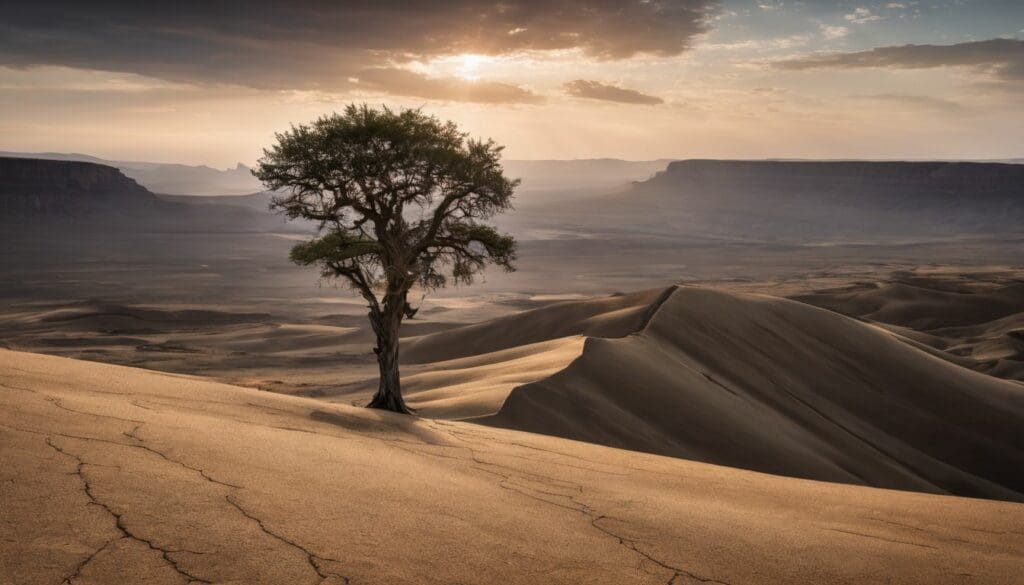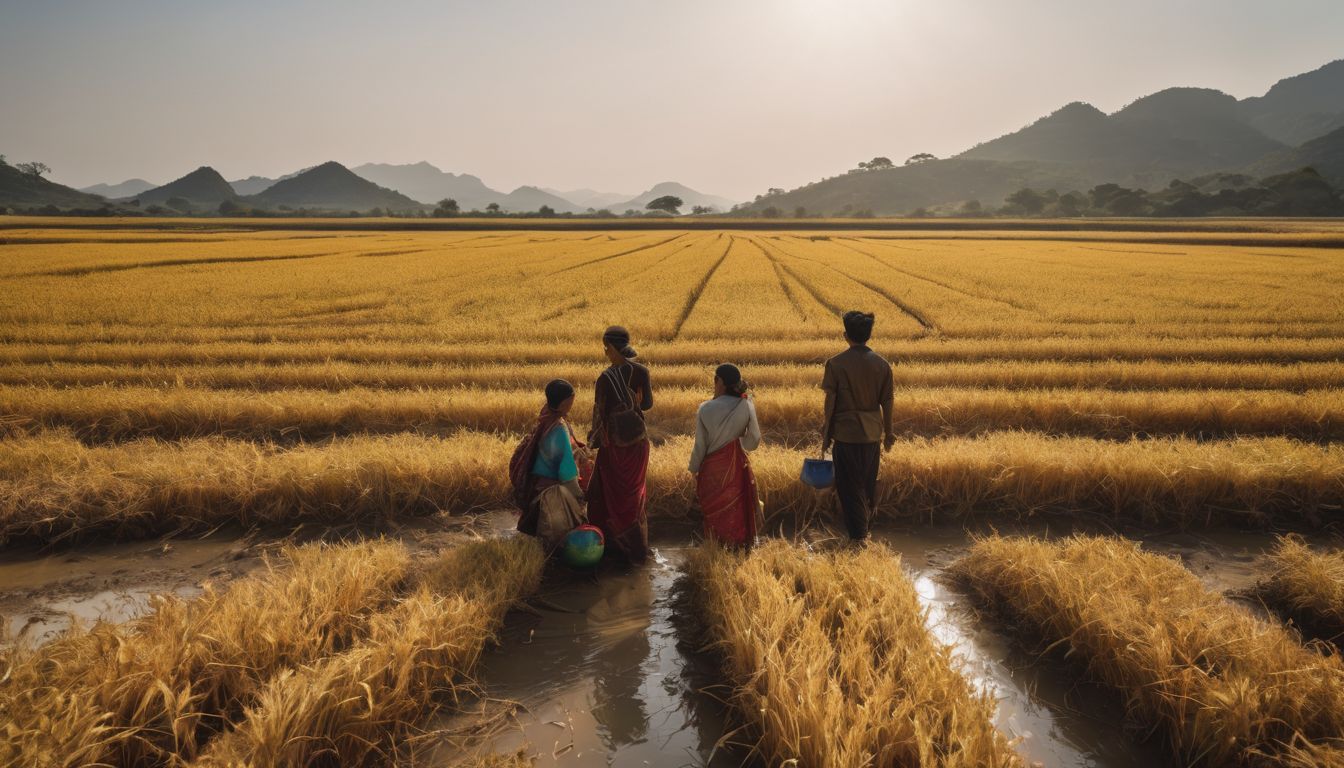We all notice the seasons are not what they used to be. Studies show that spring is arriving earlier, while winters become milder and shorter due to global warming. This article will explain these shifts, their causes, and how we can respond to protect our planet’s future.
Read on for insights into a changing world.
Key Takeaways
- Global warming is causing the seasons to change, with spring arriving earlier and winter becoming shorter. This disrupts natural ecosystems, agriculture, and affects animal migration patterns.
- Observable effects of climate change include altered precipitation patterns leading to floods and droughts, changes in wildlife behaviour, and extended or shortened growing seasons impacting food production.
- Longer and hotter summers due to global warming increase heatwaves and wildfires risk, while warmer winters affect snow cover and water availability.
- Mitigation efforts like using renewable energy sources and sustainable farming are crucial for reducing greenhouse gas emissions that alter seasonal cycles.
- Adapting to these changes is essential; it includes conserving water, adjusting agricultural practices, promoting sustainable land management, enhancing education on climate impacts, and creating resilient communities.
Understanding Seasonal Cycles and Climate Change
Seasonal cycles are the regular changes that occur in a year, influenced by various factors such as temperature, weather patterns, and the water cycle. These cycles play a crucial role in natural ecosystems and agricultural processes.
Definition of seasons
Seasons are divisions of the year marked by changes in weather, ecology, and hours of daylight due to the axial tilt of the Earth as it orbits around the sun. These periods have distinct environmental conditions and temperatures that historically could be predicted with reasonable accuracy.
The four main seasons – spring, summer, autumn (fall), and winter – follow one another in a fixed pattern each year.
In many regions, spring is known for plant growth which leads into summer with its peak heat; afterwards comes autumn’s cooler relief and harvesting time before winter closes in with its cold grip.
Each shift from one season to another dramatically alters landscapes and affects all living organisms as they adapt to these cyclical changes. Moving towards factors influencing seasonal shifts unveils deeper insights into how global warming is altering what we once considered ‘normal’ seasonal behaviors.
Factors influencing seasonal changes
Seasonal changes are influenced by various factors, including the Earth’s tilt, orbit around the sun, and its position in relation to the sun. These factors affect the amount of solar energy received by different parts of the planet throughout the year, influencing temperature and weather patterns. Other influential factors include ocean currents, atmospheric circulation patterns, and land surfaces. These elements collectively contribute to shaping the distinct seasons experienced across the globe. Additionally, variations in greenhouse gas concentrations also impact seasonal changes by affecting temperature fluctuations and precipitation patterns. Furthermore, human activities such as deforestation and industrial emissions can disrupt natural seasonal cycles by altering local climates and ecosystems.
Evidence of Changing Seasonal Patterns
Observable changes in seasonal patterns, such as earlier springs and later autumns, are becoming increasingly common. Climate models project even more drastic shifts in the coming years.
Observed changes in seasonal cycles
Global warming is causing observable changes in seasonal cycles. These changes include:
- Earlier arrival of spring: Spring is arriving earlier each year due to rising temperatures, impacting the timing of plant flowering and animal migration.
- Shorter duration of winter: Winters are becoming shorter as temperatures rise, leading to reduced snow cover, affecting water availability and ecosystems.
- Shifts in precipitation patterns: Changes in rainfall patterns are altering the timing and volume of precipitation, affecting agriculture and water resources.
- Changes in wildlife behavior: Many species are adjusting their behaviors in response to changing seasons, such as altering migration patterns and breeding times.
- Disruption of natural rhythms: Global warming is disrupting the natural balance of seasonal cycles, impacting the lifecycles of plants, animals, and insects.
- Effects on water systems: Rising temperatures are affecting evaporation rates and water storage, influencing river flows and groundwater recharge.
- Altered growing seasons: Warmer temperatures are extending growing seasons for some crops while shortening them for others, impacting agricultural productivity.
Projected changes due to global warming
As we consider the observed changes in seasonal cycles, it is essential to note the projected changes due to global warming. The impact of global warming on seasonal cycles is expected to bring about significant alterations in the way we experience and anticipate seasons. Here are the anticipated changes:
- Shifts in growing seasons for crops and vegetation, impacting agricultural productivity and food supply.
- Disruption of natural rhythms for wildlife, affecting migration patterns and ecological balance.
- Changes in precipitation patterns leading to more intense rainfall or extended drought periods, impacting water availability and ecosystems.
- Increased frequency and severity of extreme weather events such as storms, heatwaves, and hurricanes, affecting communities and infrastructure.
How Climate Change is Affecting the Seasons
Climate change is causing longer and hotter summers, resulting in heatwaves and extreme weather events. This has also led to shorter and warmer winters, impacting snowfall and the duration of freezing temperatures.
Longer and hotter summers
The climate change caused by global warming leads to longer and hotter summers. Rising temperatures intensify heatwaves, affecting human health and increasing the risk of wildfires.
Additionally, prolonged hot weather can lead to droughts, impacting water supplies and agricultural productivity. These changes in temperature have direct implications for various ecosystems, altering plant and animal life cycles and potentially leading to biodiversity loss.
Shifting seasonal patterns due to global warming result in increased heat stress on natural habitats, making it difficult for some species to survive. This requires urgent action through conservation efforts and promoting sustainable practices.
Shorter and warmer winters
Global warming has led to shorter and warmer winters in many regions. The decrease in snow cover and earlier thawing of ice have disrupted ecosystems and wildlife. Additionally, this has impacted industries like skiing and winter sports due to unreliable snowfall patterns.
These changes are a result of rising temperatures, impacting environmental balance.
Moving on to the next point “Changes in precipitation patterns”..
Changes in precipitation patterns
Changes in precipitation patterns are becoming more evident as a result of global warming. This includes an increase in extreme rainfall events, leading to flooding in some areas and droughts in others.
It is crucial for us to monitor and adapt to these changing patterns to mitigate the impact on agriculture, water resources, and overall ecosystem health.
The alterations in precipitation patterns also have implications for water availability and quality, affecting both human communities and natural habitats. As the climate continues to change, it becomes increasingly important for individuals and communities to implement sustainable water management practices while supporting initiatives aimed at reducing greenhouse gas emissions.
Impacts of Changing Seasons
The changing seasons due to global warming have led to disruption of natural habitats, affecting wildlife and plant species. Agriculture and food production are also being impacted, leading to economic and societal consequences.
Disruption of natural habitats
Global warming has led to a disruption of natural habitats, impacting the delicate balance of ecosystems. Shifts in temperature and precipitation patterns have altered the availability of resources for plants and animals, affecting their ability to thrive.
These changes have also influenced migration patterns and breeding cycles, posing significant challenges for many species as they struggle to adapt to their changing environments.
The altering landscape caused by global warming has resulted in habitat loss for various plant and animal species. This transformation is threatening biodiversity and jeopardising the survival of many organisms that rely on specific environmental conditions for their existence.
Effects on agriculture and food production
Shifting seasons affect agriculture and food production. Changes in temperature and precipitation impact crop yields, affecting food availability and prices. Farmers face challenges in adapting to these unpredictable conditions, leading to potential economic losses.
Furthermore, alterations in growing seasons disrupt the delicate balance of ecosystems that support agriculture. The changing patterns also influence pest populations and their interaction with crops, posing additional agricultural threats.
As a result, it is essential to develop resilient farming practices to mitigate these impacts on global food production.
Economic and societal impacts
As climate change continues to alter growing seasons and disrupt agricultural patterns, the resulting economic and societal impacts are far-reaching. Shifts in seasonal cycles due to global warming can lead to reduced crop yields, affecting food production and supply.
This can result in increased food prices, impacting communities that rely heavily on agriculture for sustenance and income.
Furthermore, changing seasonal patterns may affect industries dependent on specific weather conditions such as tourism, outdoor recreation, and winter sports. The ripple effects of these shifts in seasonal cycles can lead to job loss, financial strain on local economies, and overall societal disruption Keywords: Environmental impact of shifting seasons; Climate change effects on seasonal cycles.
Can We Reverse the Effects of Climate Change on Seasons?
Exploring mitigation efforts and the need for urgent action to adapt to changing seasons and promote sustainable practices. Read on to learn more about the impact of global warming on seasonal cycles.
Mitigation efforts
Mitigation efforts to combat the impact of global warming on seasonal cycles are crucial. They include:
- Implementing renewable energy sources to reduce greenhouse gas emissions and lessen the influence of climate change on seasons.
- Protecting and restoring natural habitats, such as forests and wetlands, to absorb carbon dioxide and preserve biodiversity.
- Encouraging sustainable practices in agriculture, such as organic farming and agroforestry, to minimise the disruption of growing seasons.
- Promoting energy efficiency in industries, transportation, and buildings to lower carbon footprints and mitigate climate change’s effect on seasonal patterns.
- Strengthening international cooperation and agreements to collectively combat global warming’s implications on seasonal shifts.
- Raising public awareness about climate change and its impact on seasonal cycles to foster support for environmental conservation efforts.
Adapting to seasonal changes
Adapting to seasonal changes is crucial in mitigating the impacts of climate change. It requires proactive measures and a willingness to embrace new approaches. Here are some ways to adapt to seasonal changes:
- Adjusting agricultural practices to optimise crop yields in changing growing seasons by cultivating more resilient and adaptable plant varieties.
- Implementing water conservation strategies to manage shifting precipitation patterns and ensure sustainable use of water resources during drier or wetter seasons.
- Developing innovative technologies for energy production that can harness renewable resources, reducing reliance on fossil fuels and minimising greenhouse gas emissions that contribute to global warming.
- Promoting sustainable land management practices to preserve natural habitats and biodiversity, safeguarding ecosystems from the adverse effects of changing seasonal cycles.
- Enhancing public awareness and education about climate change and its impact on seasons, encouraging communities to adopt eco-friendly lifestyles and reduce their carbon footprint.
- Collaborating with policymakers and stakeholders to formulate adaptive strategies that address the specific challenges posed by altered seasonal patterns, fostering resilience in vulnerable sectors such as agriculture, forestry, and fisheries.
- Investing in research and development of climate – resilient infrastructure and urban planning, designing cities and communities that can withstand extreme weather events associated with shifting seasonal patterns.
- Encouraging international cooperation and collective efforts to combat climate change, advocating for global initiatives aimed at reducing greenhouse gas emissions and promoting sustainable development practices worldwide.
Need for urgent action
To address the impact of climate change on seasonal cycles, urgent action is essential. Individuals, communities, and governments must implement sustainable practices to reduce greenhouse gas emissions.
Promoting renewable energy sources, conserving water, and supporting environmentally friendly policies are vital steps in mitigating the effects of global warming on seasonal patterns.
Adapting to changing seasons will also require cooperation across sectors to minimise ecological disruptions and preserve natural habitats while ensuring food security for future generations.
Promoting sustainable practices
To mitigate the impact of global warming on seasonal cycles, promoting sustainable practices is crucial. Implementing eco-friendly initiatives such as reducing carbon emissions, conserving water, and supporting renewable energy sources can help slow down climate change.
Encouraging reforestation and preserving natural habitats are also essential in maintaining the balance of seasonal cycles and protecting biodiversity.
Furthermore, advocating for sustainable agriculture practices, promoting responsible consumption and waste reduction, and supporting policies that prioritise environmental conservation are vital steps towards creating a more sustainable future.
Conclusion
In conclusion, global warming is altering our seasonal cycles, leading to longer and hotter summers and shorter, warmer winters. These changes have far-reaching implications for ecosystems, agriculture, and economies worldwide.
Urgent action is needed to mitigate the effects of climate change on seasons and promote sustainable practices for a more balanced future.
FAQs
1. How does global warming affect the seasons?
Global warming changes seasonal climate patterns, causing shifts in growing seasons and disrupting the natural seasonal cycles we’re used to.
2. What is the impact of climate change on winter and summer cycles?
Climate change, fueled by greenhouse gases, can lead to alterations in seasonal cycles, potentially making summers hotter and winters shorter or milder than before.
3. Does global warming influence other parts of nature’s cycles?
Yes, besides altering weather patterns across seasons, global warming also impacts the water cycle due to increased temperatures leading to ocean acidification.
4. Why should we worry about changes in seasonal shifts caused by climate change?
Changes in seasonal shifts have serious implications for agriculture, wildlife habitats, and our overall environment which depend on predictable seasonal patterns.





